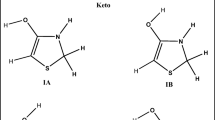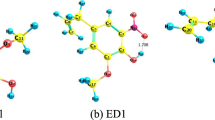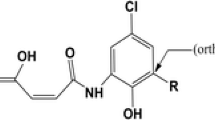Abstract
Although natural polyphenols have attracted extended attention as antioxidants, there is only limited information available on their structure-activity relationship (SAR). In addition, while often having significant antioxidant activity, amino group-containing compounds have only been sporadically studied. Often, the complex structure makes studying the individual contribution of aromatic OH or NH2 groups on the activity of these antioxidants difficult. In this work, several substituted simple phenols and anilines were selected as model compounds. Both the experimental radical scavenging activity and major structural descriptors have been determined to gain more insights into the potential SAR. Physicochemical properties pertaining to energetic and structural parameters were determined and experimental data gathered from three antioxidant assays to identify fundamental features with reasonable effect on antioxidant activity. Density functional theory (DFT) calculations were carried out at the B3LYP/6-31G(d,p) level to determine the N–H and O–H bond distances, dipole moments, logP values, highest occupied molecular orbital (HOMO) and lowest unoccupied molecular orbital (LUMO) orbital energies, HOMO-LUMO gaps, radical spin densities, proton affinities, and ionization potentials. The compounds were screened for activity against the 2,2′-azino-bis(3-ethylbenzthiazoline-6-sulphonic acid) (ABTS), 2,2-diphenyl-1picrylhydrazyl (DPPH), and peroxyl (ORAC assay) radicals. Based on the results, ABTS antioxidant activity was selected for further investigations to observe correlations with the calculated properties. The HOMO energies, bond-dissociation energy values, HOMO-LUMO gap energies, dipole moment, proton affinity, and the Hammett constants appear to show meaningful correlation with the experimental data.














Similar content being viewed by others
Abbreviations
- HOMO:
-
highest occupied molecular orbital
- LUMO:
-
lowest unoccupied molecular orbital
- ABTS:
-
2,2′-azino-bis(3-ethylbenzothiazoline-6-sulphonic acid)
- DPPH:
-
2,2-diphenyl-1-picrylhydrazyl
- ORAC:
-
oxygen radical absorbance capacity
- MS:
-
multiple sclerosis
- HAT:
-
hydrogen atom transfer
- SET:
-
single-electron transfer
- SPLET:
-
sequential proton loss electron transfer
- DMSO:
-
dimethyl sulfoxide
- μ (D):
-
dipole moment
- BDE:
-
bond-dissociation energy
- IP:
-
ionization potential
- PA:
-
proton affinity
- σ :
-
Hammett constant
References
Galkina OV (2003). J Neurochem 7:89–97
Dröge W (2002). Physiol Rev 82:47–95
Knight J (2000). Ann Clin Lab Sci 30:145–158
Bouayed J, Bohn T (2010). Oxidative Med Cell Longev 3:228–237
Slimen B, Najar T, Abderrabba M (2017). J Agric Food Chem 65:675–689
Horton W, Török M (2018) Natural and nature-inspired synthetic small molecule antioxidants in the context of green chemistry., in Green Chemistry: An inclusive Approach (Török, B., Dransfield, T., eds) Elsevier, Oxford, Cph 3.27 pp 963–979
Halake K, Birajdar M, Lee J (2016) J. Ind Eng Chem Res 35:1–7
Ackerman S, Horton W (2018) Effects of environmental factors on DNA: damage and mutations, in Green Chemistry: An inclusive Approach (Török, B., Dransfield, T. eds) Elsevier, Oxford, Cph 2.4 pp 109–128
Delanty N, Dichter MA (1998). Acta Neurol Scand 98:145–153
Rajendran P, Nandakumar N, Rengarajan T, Palaniswami R, Gnanadhas EN, Lakshminarasaiah U, Gopas J, Nishigaki I (2014). Clin Chim Acta 436:332–347
Valko M, Leibfritz D, Moncol J, Cronin MT, Mazur M, Telser J (2007). Int J Biochem Cell Biol 39:44–84
Halliwell B, Gutteridge J (1990). Methods Enzymol 186:1–85
Lin M, Beal MF (2006). Nature 443:787–795
Ames B, Shigenaga M, Hagen T (1993). Proc Natl Acad Sci U S A 90:7915–7922
Reuter S, Gutpa S, Chaturvedi MM, Aggarwal BB (2010). Free Radic Biol Med 49:1603–1616
Dai J, Mumper R (2010). Molecules 15:7313–7352
Manach C, Scalbert A, Morand C, Rémésy C, Jiménez L (2004). Am J Clin Nutr 79:727–747
Shahidi F, Ambigaipalan P (2015). J Funct Foods 18:820–897
Neto CC (2007). Mol Nutr Food Res 51:652–664
Neto CC (2011). J Sci Food Agric 91:2303–2307
Xia E, Deng G, Guo Y, Li H (2010). Int J Mol Sci 11:622–646
Azeredo H (2009). Int J Food Sci Nutr 44:2365–2376
Butera D, Tesoriere L, Gaudio F, Bongiorno A, Allegra M, Pintaudi AM, Kohen R, Livrea MA (2002). J Agric Food Chem 50:6895–6901
Gengatharan A, Dykes G, Choo W (2015). LWT - Food Sci Technol 64:645–649
Swieca M, Gawlik-Dziki U, Dziki D, Baraniak B (2017). Food Chem 221:1451–1457
Forman HJ, Davies KJ, Ursini F (2014). Free Radic Biol Med 66:24–35
Kanner J, Harel S, Granit R (2001). J Agric Food Chem 49:5178–5185
Manach C, Williamson G, Morand C, Scalbert A, Rémésy C (2005). Am J Clin Nutr 81(suppl):230S–242S
Manach C, Williamson G, Morand C, Scalbert A, Rémésy C (2005). Am J Clin Nutr 81(suppl):243S–255S
Hollman P (2014). Arch Biochem Biophys 559:100–105
Crozier A, Jaganath I, Clifford M (2009). Nat Prod Rep 26:965–1096
Scalbert A, Williamson G (2000). J Nutr 130:2073S–2085S
Walle T, Hsieh F, DeLegge M, Oatis J, Walle K (2004). Drug Metab Dispos 32:1377–1382
Foti M, Amorati R (2009). J Pharm Pharmacol 61:1435–1448
Sarmadi B, Ismail A (2010). Peptides 31:1949–1956
Klein E, Lukeš V, Cibulková Z (2006) Polovková. J Mol Struct 758:149–159
Bordwell FG, Zhang XM, Cheng JP (1993). J Org Chem 58:6410–6416
Török B, Sood A, Bag S, Tulsan R, Ghosh S, Borkin D, Kennedy AR, Melanson M, Madden R, Zhou W, Levine 3rd H, Török M (2013). Biochemistry 52:1137–1148
Valgimigli L, Pratt DA (2015). Acc Chem Res 48:966–975
Ingold KU, Pratt DA (2014). Chem Rev 114:9022–9046
Apak R, Özyürek M, Güçlü M, Çapanoğlu E (2016). J Agric Food Chem 64:997–1027
Apak R, Özyürek M, Güçlü K, Çapanoğlu E (2016). J Agric Food Chem 64:1028–1045
Lu JM, Lin P, Yao Q, Chen C (2010). J Cell Mol Med 14:840–860
Peerannawar S, Horton W, Kokel A, Török F, Török M, Török B (2017). Struct Chem 28:391–402
Becke AD (1988). Phys Rev A38:3098–3100
Lee C, Yang W, Parr RG (1988). Phys Rev B37:785–789
Gaussian 09, Revision A.02, Frisch MJ, Trucks GW, Schlegel HB, Scuseria GE, Robb MA, Cheeseman JR, Scalmani G, Barone V, Petersson GA, Nakatsuji H, Li X, Caricato M, Marenich M, Bloino J, Janesko BG, Gomperts R, Mennucci B, Hratchian HP, Ortiz JV, Izmaylov AF, Sonnenberg JL, Williams-Young D, Ding F, Lipparini, F, Egidi F, Goings J, Peng B, Petrone A, Henderson T, Ranasinghe D, Zakrzewski WG, Gao J, Rega N, Zheng G, Liang W, Hada M, Ehara M, Toyota K, Fukuda R, Hasegawa J, Ishida M, Nakajima T, Honda Y, Kitao O, Nakai H, Vreven T, Throssell, Montgomery, JA Jr, Peralta JE, Ogliaro F, Bearpark M, Heyd JJ, Brothers EE, Kudin KN, Staroverov VN, Keith T, Kobayashi R, Normand J, Raghavachari K, Rendell A, Burant JC, Iyengar SS, Tomasi J, Cossi, M., Millam JM, Klene M, Adamo C, Cammi R, Ochterski JW, Martin RL, Morokuma K, Farkas O, Foresman JB, Fox DJ (2016) Gaussian, Inc., Wallingford CT
Hansch C, Leo A, Taft W (1991). Chem Rev 91:165–195
Ali H, Abo-Shady A, Sharaf Eldeen H, Soror H, Shousha W, Abdel-Barry O, Saleh A (2013). Chem Cent J 7:53–62
Ali HM, Ali IH (2015). Med Chem Res 24:987–998
Rice-Evans C, Miller N, Paganga G (1996). Free Radic Biol Med 20:933–956
Bendary E, Francis RR, Ali HMG, Sarwat MI, El Hady S (2013). Ann Agric Sci 58:173–181
Niki E (2010). Free Radic Biol Med 49:503–515
Saqib M, Mahmood A, Akram R, Khalid B, Afzal S, Kamal GM (2015). J Pharm Appl Chem 1:65–71
Alaşalvar C, Soylu MS, Güder A, Albayrak Ç, Apaydin G, Dilek N (2014). Spectrochim Acta A: Mol Biomol Spectr 125:319–327
Zhu Q, Zhang XM, Fry A (1997). Polym Degrad Stab 57:43–50
Leopoldini M, Russo N, Toscano M (2011). Food Chem 125:288–306
Mazzone G, Malaj N, Russo N, Toscano M (2013). Food Chem 141:2017–2024
Xia EQ, Deng GF, Ge YJ, Li HB (2010). Int J Mol Sci 11:622–646
Szeląg M, Mikulski D, Molski M (2012). J Mol Model 18:2907–2916
Alabugin IV, Brescha S, dos Passos Gomes G (2015). J Phys Org Chem 28:147–162
Funding
This study received financial support from the University of Massachusetts Boston.
Author information
Authors and Affiliations
Corresponding authors
Rights and permissions
About this article
Cite this article
Horton, W., Peerannawar, S., Török, B. et al. Theoretical and experimental analysis of the antioxidant features of substituted phenol and aniline model compounds. Struct Chem 30, 23–35 (2019). https://doi.org/10.1007/s11224-018-1183-4
Received:
Accepted:
Published:
Issue Date:
DOI: https://doi.org/10.1007/s11224-018-1183-4




